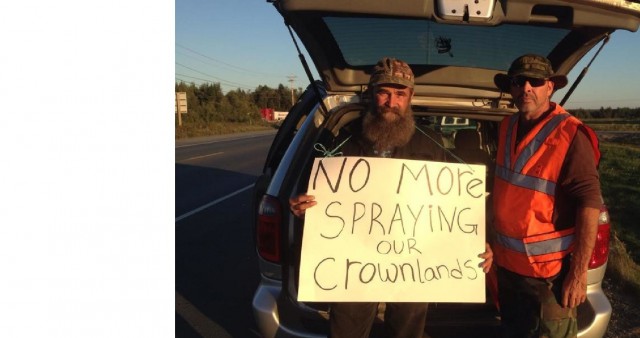A herbicide sprayed yearly and in large quantities on New Brunswick forests was recently classified as a probable cancer-causing chemical by the International Agency for Research on Cancer (IARC), an arm of the World Health Organization. The decision was published in the journal, Lancet Oncology. Glyphosate, sold under various trade names including Roundup, Vision, and Vision Max, is a broad-spectrum weedkiller used in agriculture, silviculture, recreational areas and on lawns. Globally, it is the highest-volume herbicide in use.
The IARC panel of 17 experts from 11 countries classified glyphosate as a probable carcinogen based on evidence in human and animal studies. Several studies, including one in Canada, have found a link between occupational exposure to glyphosate and increased risk of non-Hodgkin’s lymphoma.
“Glyphosate can be absorbed into the body and has been detected in the blood and urine of workers handling the chemical,” says Inka Milewski, science advisor for the Conservation Council of New Brunswick. “Glyphosate causes cancer by damaging chromosomes (DNA) which can result in mutations that lead to cancer. But it is not only workers that are affected. The IARC experts cite a 2009 study that found chromosomal damage in residents of several communities after aerial glyphosate spraying.”
Herbicides have been used on New Brunswick forests since the 1970s when pulp and paper companies were first permitted to clearcut natural forest and replace it with plantations. About 13,000 hectares of Crown forest are sprayed each year in the province. Spraying is done by helicopter for about 40 days between August and September, covering roughly 25 per cent of the softwood land cut each year.
The Conservation Council is calling for a phase-out of glyphosate use in New Brunswick’s Crown forest. “Health policy and regulations lag way behind the known science of many of the pollutants in our environment. There are plenty of examples where regulators have waited too long before acting to protect public health. Lead, DDT, radon, dioxin and cigarette smoke come to mind,” says Milewski.
Tracy Glynn, forest campaign director for the Conservation Council, says it’s time for New Brunswick to phase out aerial herbicide spraying in forests. “Quebec banned the use of glyphosate in forestry in 2001 and replaced herbicide use with thinning crews. Nova Scotia recently abandoned the public funding of herbicide spraying of their forest and is moving toward FSC certification of their forest, which would mean no more herbicides in their woods. But here in New Brunswick, we continue to fund silviculture on Crown land that includes spraying, which according to data from Natural Resources Canada, can cost the province about $1,000/ha,” says Glynn.
Three petitions, signed by thousands of New Brunswickers, against herbicide spraying in the forest have been tabled in the New Brunswick Legislature in just over a decade, the most recent in 2011. Kent County residents have recently risked arrest and are facing hefty fines for trying to stop the herbicide spraying of their woods.
“Creating good jobs and protecting our health and the health of our forest is very important to New Brunswickers,” says Glynn. “Following in our neighbour’s footsteps by using thinning crews instead of chemicals that have been connected to cancer is just good common sense.”

